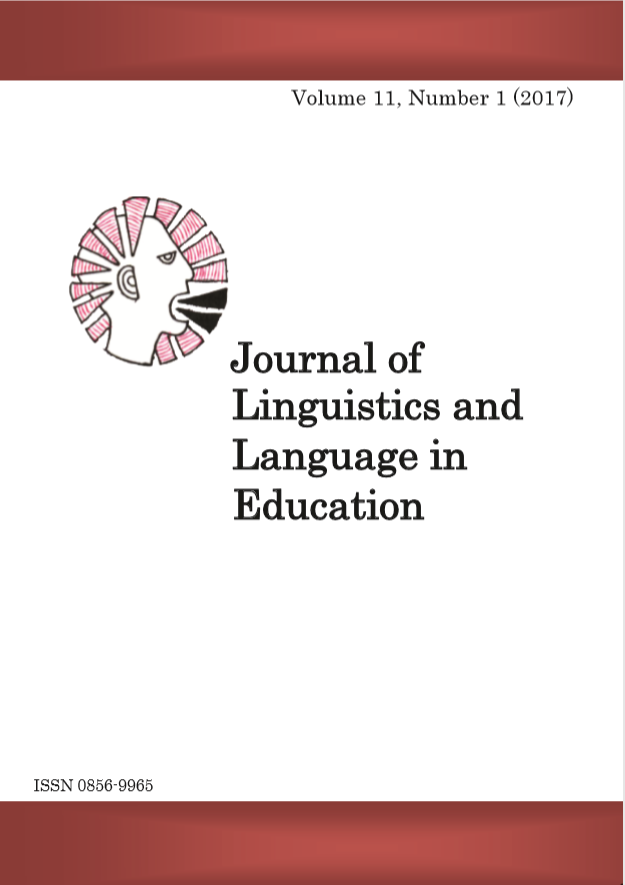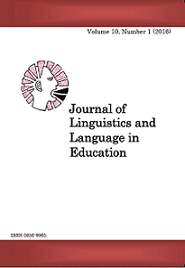The Morphosyntactic Distribution and Functions of Demonstratives in Shinyiha
Abstract
This paper examines the morphosyntactic distribution and functions of
demonstratives in Shinyiha [M23]. Specifically, the paperexamines the
forms, distribution and use of demonstratives in Shinyiha. The data
werecollected through elicitation. The findingsindicate that
demonstratives in this language constitute a class that is complex in
terms of form, function and distribution. The findings also indicate that
there is no single rule governing the distribution of demonstratives in
this language. The study reveals that, in most cases, the form of the
demonstrative in Shinyiha depends on the form of the noun class prefix,
preprefix or the root of the head noun.As regards the functions, the study
shows that demonstratives in Shinyiha perform various functions
ranging from sentential to the discourse level.The findings also show
that,in an unmarked order,the demonstrative occurs postnominally (N
DEM) to perform deictic functionwhile,in a marked order, the
demonstrative occurs prenominally (DEM N) to express definiteness,
specificity and focus
References
Abney, S. P. (1987). English Noun Phrase in its Sentential Aspect.
PhD Thesis, MIT.
Alexiadou, A. L. Haegeman, & Staurou, M. (2007). Noun Phrase in
the Generative Perspective : Berlin: Mouton de Gruyter.
Ashton, E. (1944). Swahili Grammar including Intonation. London:
Longman Gree & Co.
Batibo, H. M. (1985). Le Kesukuma (langue Bantue de Tanzanie)
Phonologgie Morphologie. Paris Center de Rech et de
Documentation Universitarie (credu).
Cornish, F. (1999). Anaphora, Discourse and Understanding:
Evidence from English and French: Oxford: Oxford
University Press & International African Institute.
Carstens, V. (1991). The Morphology and Syntax of Determiner
Pharses in Kiswahili.UCLA PhD Thesis.
Carstens, V. (1993). On Nominal Morphology & D P Structure. In S.
Mchombo (ed.). Theoretical Aspects of Bantu Grammar .
Carlifonia: CSL1Publications.
Carstens, V. (2008). Nominal Morphology and DP Structure. In S.
Mchombo (ed.). Theoretical Aspects of Bantu Grammar.
Stanford: Stanford University Press.
Cinque, G. (2005). Driving Greenberg's Universal 20 and its
Exceptions. Linguistic Inquiry, 36(3): 315-332.
Dianne, F. A. G.& Samwel, M.(2017). A Grammar of Moloko, African
Languages Grammars and Dictionaries . Berlin: Language
Science Press.
Diessel, H. (1999). The Morphosyntax of Demonstratives in
Synchrony and Diachrony. Linguist: Typology 3:1-49.
Dixon, R. M. W. (2003). Demonstratives. A Cross Linguistic
Typology. Studies in Language , 27(1):61-112.
Frank, M. (1972). Modern English: A Practical Reference Guide. New
Jersey: Prentice Hall Inc.
Giusti, G. (1996). Is there a Focus n and a Topic P in the Noun
Phrase Structure? l6:105-128.
Givon, T. (2001). Syntax, an Introduction, Vol.1, Amsterdam &
Philadelphia: John Benjamnins Publishing Company.
Greenberg, J. (1963). Some Universals of Grammar with Particular
Reference to the Order of Meaningful Elements. Universals
of Language , 73-113
Guardiano, C. (2012). Demonstratives, Word Order and the DP
between Syntax and Semantics: Cross-linguistic Remarks:
Studies in Greek Linguistics , 32:100-115.
| The Morphosyntactic Distribution and Functions of Demonstration in Shinyiha
Huang, Y. (2000). Anaphora, A Cross Linguistic Approach. Oxford.
Oxford University Press.
Hyman, L. M. & Katamba F. X. (1993). The Augment in Luganda:
Syntax or Pragmatics. In S. Mchombo (ed.). Theoretical
Aspects of Bantu Grammar. Stanford, CA: CSL1.
Johnston, H. J. (1919). Comparative Study of Bantu and Semi-Bantu
Languages. OxfordUniversity Press.
Levinson, S. C. (2004). Deixis and Pragmatics. In L. Horn & G. Ward
(eds.). The Handbook of Pragmatics. Oxford: Blackwell.
Lyons, J. (1977). Semantics. Vol. 1. Cambridge: Cambridge
University Press.
Mkude. D. J. (1974). A Study of Kikaguru Syntax with Special
Reference to Transformational History of Sentences with
Permitted Subject and Object. London: University of London.
Murphy, R. (2009). English Grammar in Use. Cambridge: Cambridge
University press.
Navarreta, C. (2004). Resolving Individual and Abstract Anaphora in
Texts and Dialogues. Proceedings of the 20th International
Conference on Computational Linguistics, Association for
computational Linguistics. Stroudsburg, PA, USA, Article 23.
DOI 14311511220355.1220389 (Last consulted 29th March
.
Ndomba, R. (2017). The Definite Article in Swahili. Journal of
Linguistics and Language in Education, 11(2).
Nicolle, S. (2004). Concise Grammar of Digo Language.
Nicolle, S. (2007). Metarepresentational Demonstratives in Digo. In
A. Rand, N. A. Nilsen & O. Keja (eds.). Interpreting
Utterances: Pragmatics and its Interfaces: Essays in Honour
of Thorstain Frethein. Oslo: Novus: 127-146.
Puturusi, M. (2016). The Students Difficulties in Using
Demonstratives. Journal Pendidikan Bahasa Dan Sastra
Inggris, 5(90).
Radford, A. (2004), Minimalist Syntax: Exploring the Structure of
English. Cambridge: Cambridge University Press.
Roberts, I. (2011). FOFC in DP: Universal 20 and the Nature of
Demonstratives. MS. In S. A. Mchombo (ed.). Theoretical
Aspects of Bantu Grammar . Cambridge: Cambridge
University Press.
Rugemalira, J. M. (2007). The Structure of the Noun Phrase. SOAS
Working Papers in Linguistics , 15:135-148.
Shobirin, R. M. (2008). Basic English Grammar . Jakarta: PT Tonga
Pustaka.
Journal of Linguistics and Language in Education Volume 14, Number 2 (2020) |127
Sideeg, A. (2016). Key Arguments for the Determiner Phrase
Hypothesis. Journal of Humanities and Social Sciences,
(2): 18-25.
Valois, D. (1991). The Internal Syntax of DP. UCLA PhD Thesis
Downloads
Published
Issue
Section
License
Copyright © by Department of Foreign Languages and Linguistics, University of Dar es Salaam
All rights reserved. No part of this publication may be reproduced or transmitted in any form or by any means, electronic or mechanical, including photocopying, recording, or any information storage or retrieval system, without permission in writing from the publisher, except for short extracts in fair dealing, for research or private study, critical scholarly review or discourse with an acknowledgement.



